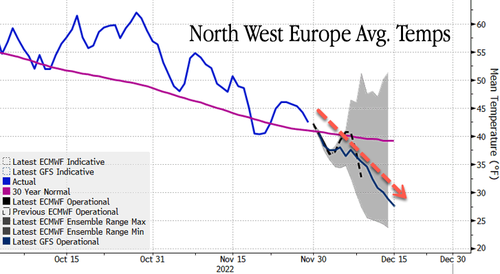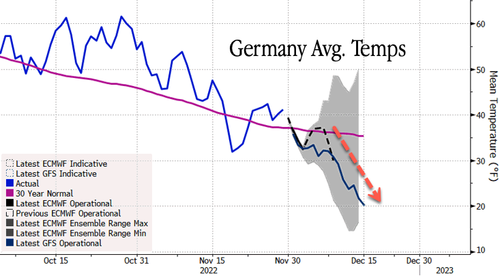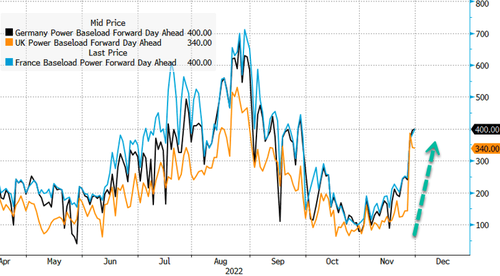'Greenland Block' Could Pour Arctic Air Across EU In First Proper Test Of Power Grids
Temperatures across Northwest Europe are set to dive well below average for the first half of December as an Arctic blast will be the first real test for the energy-stricken continent's power systems.
Bloomberg data shows average temperatures will begin sliding Wednesday under a 30-year trendline of about 40 degrees Fahrenheit to 27 degrees by the midpoint of December. This means that temperatures will be 10 degrees below the historical average, a sure sign that heating demand will rapidly increase.

Heating demand is set to explode.

Meteorologists at Klart.se in Sweden explained the Arctic chill is due to "a so-called Greenland blocking" event. The weather phenomenon "is starting to take shape in the middle or end of next week, which will send cold Arctic air in over Europe," they continued and described the blocking pattern as a high-pressure zone over Greenland that restricts weather systems from running into it and pushes the jet stream south.
Temperatures across the largest European economy are expected to crater in the next two weeks to an average of 20 degrees.

France will hover below freezing.

The good news for Europe is that warmer-than-average autumn allowed natural gas reserves to fill up about 95%. Now comes the drawing period as heating demand is set to surge.

Dutch NatGas benchmark TTF prices have already started to reverse on the prospects of colder weather.

Power prices are moving higher. The Nordic daily rate for Wednesday jumped 8.2% to 373.23 euros ($387) per megawatt- hour.

German, French, and UK power prices are also increasing.

And it begins: All that matters for Europe now are just how severe winter will be and the rate at which it draws NatGas from storage.



/cloudfront-us-east-2.images.arcpublishing.com/reuters/CKB3MLPHQJILVFOMXP7EC5C3SQ.jpg)








